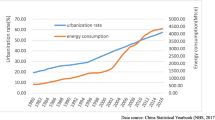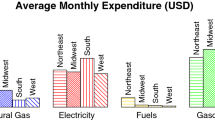Abstract
Urbanization has transformed daily lives and industrial production in China. We investigate the effects of this process on Chinese energy consumption patterns. Three energy-consuming sectors intricately associated with urbanization are identified and analyzed: residential households, transportation, and the building materials industry. Urbanization has profoundly affected each; moreover, the latter two are high energy consumption and potentially high carbon producing. We estimate energy consumption attributable to each sector to quantitatively evaluate their impacts on societal transition. Transportation and the production of building materials are identified as the most significant linkages from urbanization to energy consumption. Strikingly, despite the large increase in the proportion of the population that is urban, the share of urban energy consumption, as estimated here, in total energy consumption has remained stable. This suggests that economic growth, in the form of the production of goods for export and domestic consumption, is the most important driver of energy demand in China.











Similar content being viewed by others
References
Akinobu, M., Yasuhiko, K., Mu, H. L., & Zhou, W. S. (2008). Electricity demand in the Chinese urban household-sector. Applied Energy, 85(12), 1113–1125.
Burak, G., & Karen, C. S. (2008). Environmental impacts of urban growth from an integrated dynamic perspective: A case study of Shenzhen, South China. Global Environmental Change, 18(4), 720–735.
Cai, J., & Jiang, Z. G. (2008). Changing of energy consumption patterns from rural households to urban households in China: An example from Shaanxi Province, China. Renewable and Sustainable Energy Reviews, 12(6), 1667–1680.
Chang, S. Y., Hu, X. J., Ou, X. M., & Zhang, X. L. (2010). Decomposition analysis of intercity passenger transportation energy consumption in China (in Chinese). China Population, Resource and Environment, 20(3), 24–29.
Chen, X., & Yuan, H. W. (2008). An empirical study on factors influencing China’s residential energy consumption behavior (in Chinese). Consumer Economics, 24(5), 47–50.
Guo, K. S. (2002). An economic analysis of the relationship between industrialization and urbanization (in Chinese). Social Sciences in China, 2, 44–55.
He, K. B., Yu, X. C., Lu, Y. Q., Hao, J. M., & Fu, L. X. (2003). Characterization of urban air pollution sources (in Chinese). Urban Environment & Urban Ecology, 16(6), 269–271.
Huang, S. L., & Chen, C. W. (2005). Theory of urban energetics and mechanisms of urban development. Ecological Modelling, 189(1–2), 49–71.
Huang, S. L., Lai, H. Y., & Lee, C. L. (2001). Energy hierarchy and urban landscape system. Landscape Urban Plan, 53(1–4), 145–161.
Jones, D. W. (1991). How urbanization affects energy-use in developing countries. Energy Policy, 19(7), 621–630.
Jones, D. W. (2004). Urbanization and energy. In C. J. Cleveland (Ed.), Encyclopedia of energy (pp. 329–335). Amsterdam: Elsevier.
Li, L. C., & Wu, W. H. (2008). Energy efficiency and its developing trend of Chinese transport sector (in Chinese). Comprehensive Transportation, 3, 16–20.
Liang, J. S., Hong, L. X., & Cai, J. M. (2009). The decomposition of energy consumption growth during the process of China’s urbanization: 1985–2006 (in Chinese). Journal of Natural Resources, 24(1), 20–29.
Liu, Y. B. (2009). Exploring the relationship between urbanization and energy consumption in China using ARDL (autoregressive distributed lag) and FDM (factor decomposition model). Energy, 34(11), 1846–1854.
Lu, Z., Huang, Q. H., Lu, J., & Zhou, W. F. (2005). Process and problems of industrialization and urbanization in China (in Chinese). China Industrial Economy, 12, 5–13.
Odum, H. T., & Odum, E. C. (1981). Energy basis for man and nature. New York: McGraw-Hill.
Odum, H. T., & Peterson, L. L. (1972). Relationship of energy and complexity. Architecture and Design, 43(10), 624–629.
Parikh, V., & Shukla, J. (1995). Urbanization, energy use and greenhouse effects in economic development: Results from a cross-national study of developing countries. Global Environmental Change, 5(2), 87–103.
Shen, L., Cheng, S. K., Aaron, J., Gun, S., & Wan, H. (2005). Urbanization, sustainability and the utilization of energy and mineral resources in China. Cities, 22(4), 287–302.
State Statistical Bureau. (1996–2009). China statistical yearbook 1996–2009. Online version, http://www.stats.gov.cn/tjsj/ndsj.
State Statistical Bureau & Energy Bureau. (1991–2007). China Energy Statistical Yearbook. Beijing: Chinese Statistics Press.
The Central People’s Government of the People Republic of China. (2006). The compendium of the “Eleventh Five-Year Plan of domestic economy and society development” (in Chinese). http://theory.people.com.cn/GB/41179/41232/4210880.html.
The National People’s Congress of the People Republic of China. (2008). Circular economy promotion law (in Chinese). Online version, http://www.npc.gov.cn/npc/zt/2008-12/25/content_1494750.htm.
Wu, W. H., Fan, H., Li, L. C., & Yang, H. N. (2008). Energy efficiency, energy saving potential and strategy analysis of Chinese transport sector (in Chinese). Macroeconomics, 6, 28–33.
Zhao, X. B. (2011). Review on the development of the socialist legal system with Chinese characteristics in China (in Chinese). Online version, http://www.npc.gov.cn/npc/zt/qt/2011zgtsshzyfltx/2011-02/17/content_1628639.htm.
Zhou, S. L., Wang, Y. Z., & Shen, Z. Y. (2008). Industrialization and urbanization in China (in Chinese). Beijing: Economy & Management Publishing House.
Zhu, X. L., Zhang, Y. H., Zeng, L. M., & Wang, W. (2005). Source identification of ambient PM2. 5 in Beijing (in Chinese). Research of Environmental Sciences, 18(5), 1–5.
Acknowledgments
The authors greatly appreciate the comments from anonymous reviewers and the guest editor, who provided valuable insights and helpful information for this study. We are also grateful to the Ministry of Science and Technology of China for its financial support (No. 2009BAC64B01).
Author information
Authors and Affiliations
Corresponding author
Rights and permissions
About this article
Cite this article
Zhou, W., Zhu, B., Chen, D. et al. Energy consumption patterns in the process of China’s urbanization. Popul Environ 33, 202–220 (2012). https://doi.org/10.1007/s11111-011-0133-5
Published:
Issue Date:
DOI: https://doi.org/10.1007/s11111-011-0133-5




